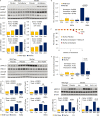A deleterious gene-by-environment interaction imposed by calcium channel blockers in Marfan syndrome
- PMID: 26506064
- PMCID: PMC4621743
- DOI: 10.7554/eLife.08648
A deleterious gene-by-environment interaction imposed by calcium channel blockers in Marfan syndrome
Abstract
Calcium channel blockers (CCBs) are prescribed to patients with Marfan syndrome for prophylaxis against aortic aneurysm progression, despite limited evidence for their efficacy and safety in the disorder. Unexpectedly, Marfan mice treated with CCBs show accelerated aneurysm expansion, rupture, and premature lethality. This effect is both extracellular signal-regulated kinase (ERK1/2) dependent and angiotensin-II type 1 receptor (AT1R) dependent. We have identified protein kinase C beta (PKCβ) as a critical mediator of this pathway and demonstrate that the PKCβ inhibitor enzastaurin, and the clinically available anti-hypertensive agent hydralazine, both normalize aortic growth in Marfan mice, in association with reduced PKCβ and ERK1/2 activation. Furthermore, patients with Marfan syndrome and other forms of inherited thoracic aortic aneurysm taking CCBs display increased risk of aortic dissection and need for aortic surgery, compared to patients on other antihypertensive agents.
Keywords: Amlodipine; ERK; Hydralazine; Marfan syndrome; TGF-β signaling; Verapamil; aortic aneurysm; calcium channel blocker; chromosomes; genes; human; human biology; medicine; mouse; protein kinase C.
Conflict of interest statement
HCD: Reviewing editor, eLife. The other authors declare that no competing interests exist.
Figures












References
-
- Cohn RD, van Erp C, Habashi JP, Soleimani AA, Klein EC, Lisi MT, Gamradt M, ap Rhys CM, Holm TM, Loeys BL, Ramirez F, Judge DP, Ward CW, Dietz HC. Angiotensin II type 1 receptor blockade attenuates TGF-beta-induced failure of muscle regeneration in multiple myopathic states. Nature Medicine. 2007;13:204–210. doi: 10.1038/nm1536. - DOI - PMC - PubMed
-
- Cook JR, Clayton NP, Carta L, Galatioto J, Chiu E, Smaldone S, Nelson CA, Cheng SH, Wentworth BM, Ramirez F. Dimorphic effects of transforming growth factor-β signaling during aortic aneurysm progression in mice suggest a combinatorial therapy for Marfan syndrome. Arteriosclerosis, Thrombosis, and Vascular Biology. 2015;35:911–917. doi: 10.1161/ATVBAHA.114.305150. - DOI - PMC - PubMed
-
- Doblinger E, Höcherl K, Mederle K, Kattler V, Walter S, Hansen PB, Jensen B, Castrop H. Angiotensin AT1 receptor-associated protein Arap1 in the kidney vasculature is suppressed by angiotensin II. American Journal of Physiology. Renal Physiology. 2012;302:F1313–F1324. doi: 10.1152/ajprenal.00620.2011. - DOI - PubMed
Publication types
MeSH terms
Substances
Grants and funding
LinkOut - more resources
Full Text Sources
Other Literature Sources
Medical
Molecular Biology Databases
Miscellaneous

